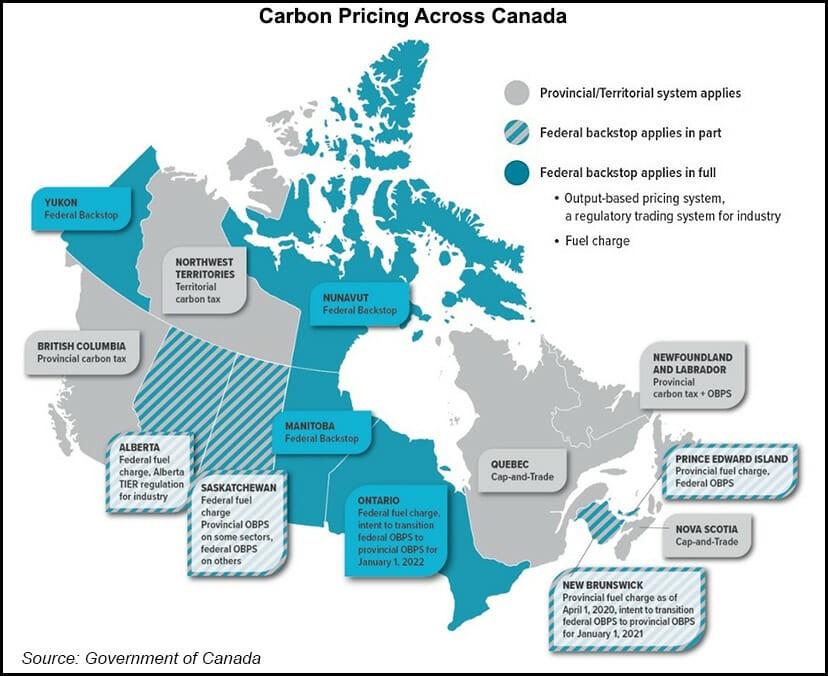The Canadian federal government collects billions of dollars in a special carbon tax that has applied primarily to fuels used by consumers, although there is also a large emitter carbon tax as well. The idea is to raise the cost of something we don’t want, in this case carbon, and let citizens and the free market figure out the best way to reduce their carbon output.
The marketing spin on this is a “price on pollution“.
How Much Money Does The Canadian Federal Government Collect In Carbon Tax?
In the year 2020 the parliamentary budget officer estimated that Canada would collect $2.6 billion in carbon tax levies.
How Much Money Does The Canadian Federal Government Pay Out in Climate Action Incentives?
To minimize hardship, nearly 100% of carbon tax is returned to Canadian citizens and companies in the form of the Climate Action Incentive Payment, which in 2022 was $2.5 billion.
These numbers will increase overtime. The price per tonne of carbon in 2022 is $50 per ton but will reach $170 per ton by 2030 and the money will be returned the citizens in cash rebates.
Do Canadian Citizens Need To Apply For the Climate Action Incentive / Carbon Tax Rebate?
No, if you filled out a Canadian tax return, you are registered and will automatically receive quarterly payments from the Canadian Federal Government.
I am a single person in Alberta, so this was my most recent payment as it appeared in my bank statement:
| Oct 14, 2022 | Climate Action Incentive CANADA | $134.75 |
Why Collect Carbon Tax, Then Just Pay It Back?
A reasonable person would ask why any government would collect money and then just pay nearly 100% of it back to its citizens. The reason is that a carbon tax raises the cost of something citizens have decided they don’t want (carbon) while not taking money away from Canadians.
This simple dance of collecting money on specific items (like fuel) that are frequently used, and then giving it back infrequently (i.e. quarterly or annually), results in consumers reducing their consumption of carbon because they see the increased price of it daily. Conversely these tax paying consumers look at the money returned to them via the climate action incentive program as a windfall, that does not play into their carbon consumption.
This is first year economics; raise the price of something and people will use less of it. People can reduce their carbon consumption in many ways:
- turning down their thermostats
- buying more efficient heating systems like
- high efficiency furnaces
- heat pumps
- solar heating
- geothermal heating
- closing off unused rooms in the house for heating
- buying a smaller more fuel efficient vehicle
- using remote meeting software like Zoom and Teams, rather than flying to meet face to face
- buying the same size vehicle with a modern high efficiency gasoline engine
- buying a new energy vehicle like
- a plug-in hybrid vehicle
- a battery electric vehicle
- even a hydrogen vehicle in the few markets that support those
- using solar panels when camping, instead of generators
- adding solar panels to their house
- adding battery electricity storage to their current solar panels
- moving closer to where you work to reduce travel cost
- using your bicycle more or using an electric scooter for short trips
- using public transit
This is not intended to be an exhaustive list it’s simply to point out that a carbon tax punishes what is not liked while leaving the workaround solution to individuals and companies. It is a very right wing way to solve the problem because it does not pick winners and losers by prescribing solutions. The free market will figure out the solution and new solutions that we haven’t even thought of yet will be developed.

What Is The Canadian Carbon Tax Charged On?
Here is a table lifted directly from the Canadian Governments CRA website which shows that the carbon tax is charged on everything from airplane fuels, to coal, to natural gas:
| Type | April 1, 2019 to March 31, 2020 | April 1, 2020 to March 31, 2021 | April 1, 2021 to March 31, 2022 | Beginning April 1, 2022 |
|---|---|---|---|---|
| Aviation gasoline | $0.0498 per litre | $0.0747 per litre | $0.0995 per litre | $0.1244 per litre |
| Aviation turbo fuel | $0.0516 per litre | $0.0775 per litre | $0.1033 per litre | $0.1291 per litre |
| Butane | $0.0356 per litre | $0.0534 per litre | $0.0712 per litre | $0.0890 per litre |
| Coke | $63.59 per tonne | $95.39 per tonne | $127.19 per tonne | $158.99 per tonne |
| Coke oven gas | $0.0140 per cubic metre | $0.0210 per cubic metre | $0.0280 per cubic metre | $0.0350 per cubic metre |
| Combustible waste | $39.95 per tonne | $59.92 per tonne | $79.89 per tonne | $99.87 per tonne |
| Ethane | $0.0204 per litre | $0.0306 per litre | $0.0408 per litre | $0.0509 per litre |
| Gas liquids | $0.0333 per litre | $0.0499 per litre | $0.0666 per litre | $0.0832 per litre |
| Gasoline | $0.0442 per litre | $0.0663 per litre | $0.0884 per litre | $0.1105 per litre |
| Heavy fuel oil | $0.0637 per litre | $0.0956 per litre | $0.1275 per litre | $0.1593 per litre |
| High heat value coal | $45.03 per tonne | $67.55 per tonne | $90.07 per tonne | $112.58 per tonne |
| Kerosene | $0.0516 per litre | $0.0775 per litre | $0.1033 per litre | $0.1291 per litre |
| Light fuel oil | $0.0537 per litre | $0.0805 per litre | $0.1073 per litre | $0.1341 per litre |
| Low heat value coal | $35.45 per tonne | $53.17 per tonne | $70.90 per tonne | $88.62 per tonne |
| Methanol | $0.0220 per litre | $0.0329 per litre | $0.0439 per litre | $0.0549 per litre |
| Naphtha | $0.0451 per litre | $0.0676 per litre | $0.0902 per litre | $0.1127 per litre |
| Natural gas, marketable | $0.0391 per cubic metre | $0.0587 per cubic metre | $0.0783 per cubic metre | $0.0979 per cubic metre |
| Natural gas, non-marketable | $0.0517 per cubic metre | $0.0776 per cubic metre | $0.1034 per cubic metre | $0.1293 per cubic metre |
| Petroleum coke | $0.0767 per litre | $0.1151 per litre | $0.1535 per litre | $0.1919 per litre |
| Pentanes plus | $0.0356 per litre | $0.0534 per litre | $0.0712 per litre | $0.0890 per litre |
| Propane | $0.0310 per litre | $0.0464 per litre | $0.0619 per litre | $0.0774 per litre |
| Still gas | $0.0540 per cubic metre | $0.0810 per cubic metre | $0.1080 per cubic metre | $0.1350 per cubic metre |
NOTE: This table is for Alberta, Saskatchewan, Manitoba, Ontario, and New Brunswick. Other Provinces have other rates.
If you are wondering where those numbers came from, it it based on the carbon intensity of each type of fuel and then multiplied by the “cost of carbon” the Federal Government is using, which increases every year:
| Jan 2020 | $20/tonne |
| Apr 2020 | $30/tonne |
| Apr 2021 | $40/tonne |
| Apr 2022 | $50/tonne |
| 2023 | $65/tonne |
| 2024 | $80/tonne |
| 2025 | $95/tonne |
| 2026 | $110/tonne |
| 2027 | $125/tonne |
| 2028 | $140/tonne |
| 2029 | $155/tonne |
| 2030 | $170/tonne |
Do All Canadians Receive The Same Carbon Tax Rebate?
No, and that makes sense because people in different parts of the country have different fuel needs. For instance on the East Coast it is not uncommon to still use home heating oil, whereas in Alberta virtually everyone heats with natural gas.
How Much Money Will I Receive from the the Climate Action Incentive?
As we mentioned the payouts are differ by Province:
BRITISH COLUMBIA Climate Action Incentive
A BC climate action tax credit (BCCATC) is available to residents through an income-based system that equates to about $174 per adult and $51 per child. It will go up to $193.50 and $56.50 respectively on July 1, 2022. However, this rebate only qualifies if you meet the income threshold.
https://www.canadadrives.ca/blog/news/carbon-taxes-and-carbon-tax-rebates-in-canada-explained?
ALBERTA Climate Action Incentive
The province currently charges $50 per tonne on emissions, which equals an annual rebate of $1,079 for a family of four. That’s $539 for a single adult, $270 for the second adult, and $135 per child. For a single parent, the first child qualifies for $270.
https://www.canadadrives.ca/blog/news/carbon-taxes-and-carbon-tax-rebates-in-canada-explained?
SASKATCHEWAN Climate Action Incentive
In Saskatchewan, the carbon tax is $50 per tonne and rebates top out at $1,101 for families of four, while a single individual can expect $550. For a single parent, the first child qualifies for $275.
https://www.canadadrives.ca/blog/news/carbon-taxes-and-carbon-tax-rebates-in-canada-explained?
MANITOBA Climate Action Incentive
For rebates, Manitoba families of four should receive $832 in carbon tax rebates this year. That’s $416 for the first adult, $208 for the spouse and $104 per child. For a single parent, the first child qualifies for $208.
https://www.canadadrives.ca/blog/news/carbon-taxes-and-carbon-tax-rebates-in-canada-explained?
ONTARIO Climate Action Incentive
The carbon tax rebates in Ontario are $745 for a family of four. That works out to $373 for a single adult or first adult in a couple, with the second adult getting $186. Each child is entitled to $93. For a single parent, the first child qualifies for $186.
https://www.canadadrives.ca/blog/news/carbon-taxes-and-carbon-tax-rebates-in-canada-explained?
QUEBEC Climate Action Incentive
The only other province besides BC to have its own provincial carbon tax in place, before the federal government initiated theirs in 2018, is Quebec.
Quebec has a cap-and-trade system, setting caps on emissions by industry. Companies that cannot reduce their emissions below that cap must buy credits from a carbon market shared with California. While Quebec mostly targets energy producers with its system, drivers in the Montreal area cough up a tax of three cents per litre on gas.
https://www.canadadrives.ca/blog/news/carbon-taxes-and-carbon-tax-rebates-in-canada-explained?
NEW BRUNSWICK
PEI
The province recently tabled legislation that will deliver $140 rebates to P.E.I. residents in July 2022. That will be only for those with incomes under $50,000. Most revenue from Prince Edward Island’s carbon levy goes towards provincial initiatives, and to offset the reduction in provincial gas taxes used as a way to shield against the federal levy’s impact.
https://www.canadadrives.ca/blog/news/carbon-taxes-and-carbon-tax-rebates-in-canada-explained?
NOVA SCOTIA
Nova Scotia has a similar cap and trade system as Quebec. This system, implemented in January 2019, meets the federal standards in limiting greenhouse gas emissions. It, therefore, does not participate in the federal carbon tax rebate program.
https://www.canadadrives.ca/blog/news/carbon-taxes-and-carbon-tax-rebates-in-canada-explained?
NEWFOUNDLAND
Newfoundland adopted a similar approach to P.E.I., reducing its gas tax to offset any pain at the pumps. The province will raise its price to $50 per tonne later in 2022.
https://www.canadadrives.ca/blog/news/carbon-taxes-and-carbon-tax-rebates-in-canada-explained?
NWT, YUKON & NUNAVUT
Yukon and Nunavut signed on to the federal carbon tax plan, with Yukon collecting revenue and distributing the rebates. Rebates are in the range of $80 per individual and a little more if you live outside of Whitehorse. Nunavut covers half the carbon levy, reducing its gas price increase by half. It does not offer rebates.
https://www.canadadrives.ca/blog/news/carbon-taxes-and-carbon-tax-rebates-in-canada-explained?
The Politics of Carbon Taxes In Canada
The politics on Carbon Taxes are reversed from what they should be. So called right wing governments don’t like carbon taxes, instead preferring to pick winners and losers to reduce carbon. Conversely, left wing political parties generally want carbon taxes.
It is a very odd political situation, and we think that what happened was the left wing “Liberal” party actually listened to economists who unanimously say that carbon taxes are the most efficient and fair way to reduce carbon, and that means right wing “Conservative” parties were required to take the opposite position even though it is against their stated principles.
Conclusion
Just the fact that you are reading this indicates that you are considering changing your carbon production and that is the goal. It is not to have you run out and buy an electric car and solar panels today, but rather to incentivize you to think about carbon and, when your next vehicle, furnace, or electricity purchase is due, that you choose the more efficient option.



0 Comments